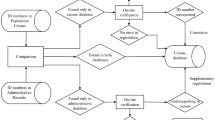Abstract
Background: The People's Republic of China (PRC) has conducted several different population policies since its establishment. Although fertility has declined dramatically in the past three decades, the degree to which this was the result of the different population policies is still under debate. Purpose: We attempt to evaluate the effect of the different formal population policies conducted in the PRC by looking at the fertility behavior of rural women. Unlike urban women, rural women experienced less social control (in the absence of a work unit) and received fewer benefits from adhering to the one-child policy. Data: The data analyzed were collected from a stratified sample of households from 288 villages in 9 counties of Hebei Province, PRC, between 1996 and 1999. The number of children ever born was reported by 4,168 ever-married women aged 25 and over who had had at least one birth. Findings: Our analysis indicates that the formal population policies of the PRC had little effect on the number of children ever born to rural women in Hebei. These retrospective data, by cohort, indicate consistently declining fertility since the revolution (1949). Limited child bearing was associated with age and the level of education. Controlling for the effect of age and education, women born after 1960, at whom the one-child policy was directed, actually had more children than older women. Conclusions: The Chinese fertility decline, at least as reflected in the experience of rural women in Hebei Province, derived mainly from secular changes in women's access to education and other social resources rather than from the direct effects of population policies.
Similar content being viewed by others
References
Anson, O., Sun, S., Zhang, W. & Haanappel, F.W. (2003). The Village Doctors in Different Ownership Clinics in China's Countryside. Amsterdam: Royal Tropical Institute.
Bogg, L. (1998). Family planning in China: Out of control? American Journal of Public Health 88: 649–651.
China YearBook (1998, 1999). Beijing: China Statistical Publishing House.
Cooney, R.S. & Li, J. (1994). Household registration types and compliance with the “one child” policy in China, 1979–1989, Demography 31: 21–32.
Cooney, R.S., Wei, J. & Powers, M.G. (1991). The one child certificate in Hebei province, China: Acceptance and consequences, 1979–1988, Population Research and Policy Review 10: 137–155.
Greenhalgh, S., Zhu, C. & Li, N. (1994). Restraining population growth in three Chinese villages, 1988–1993, Population and Development Review 20: 365–395.
Hesketh, T. & Zhu, W.X. (1997). The one child family policy: The good, the bad, and the ugly, British Medical Journal 314: 1685–1587.
Karkal, M. (1986). Family planning in India: A critical appraisal, International Review of Natural Family Planning 10: 23–42.
Larsen, U. (1990). An assessment of the one-child policy in China from 1980 to 1985, European Journal of Population 6: 257–284.
Lavely, W. & Freedman, R. (1990). The origins of the Chinese fertility decline, Demography 27: 357–367.
Li, J. (1995). China's one-child policy: How and how well has it worked? A case study of Hebei Province, 1979–1988, Population and Development Review 21: 563–585.
Li, J. & Cooney, R.S. (1993). Son preference and the one child policy in China: 1979–1988, Population Research and Policy Review 12: 277–296.
Ren, X.S. (1996). Regional variation in infant survival in China, Social Biology 43: 1–19.
Ming, T., He, Q. & Huang, H.Y. (1995). Living Arrangements of elderly women and men in Chinese cities, Sociological Spectrum 15: 491–510.
Rigdon, S.M. (1996). Abortion law and practice in China: An overview with comparisons to the United States, Social Science & Medicine 42: 543–560.
Riley, N. & Gardner, R.W. (1997). China's population: A review of the literature. Commissioned paper for the IUSSP International Conference, Beijing, October 1997.
Roy, S.G. (1993). Demography of China and India: A comparative study, IUSSP International Population Conference, Montreal, Proceedings 4: 173–186.
Schultz, T.P. & Zeng, Y. (1995). Fertility in rural China: Effects of local family planning and health programs, Journal of Population Economics 8: 329–359.
Shuval, J.T. and Anson, O. (2000). Social Structure and Health in Israel. Jerusalem: Magnes, The Hebrew University Press (Hebrew).
Thomas, N.H. & Aiping, M. (2000). Fertility and population policy in two counties in China 1980–1991, Journal of Biosocial Science 32: 125–140.
Tsui, A.O. (2001). Population policies, family planning programs, and fertility: The record, Population and Development Review 27(Suppl): 184–204.
White, T. (1994). Two kinds of production: The evolution of China's family planning policy in the 1980, Population and Development Review 20: 137–158.
Yu, P. (1996). Family planning program and women's status in China, pp. 16–22 in The Population Situation in China. Beijing: China Population Association.
Zhao, Z. (2000). Coresidential patterns in historical China: A simulation study, Population and Development 26: 263–295.
Zeng, Y. (1996). A demographic profile of marriage and family in China, pp 23–29 in The Population Situation in China. Beijing: China Population Association.
Author information
Authors and Affiliations
Rights and permissions
About this article
Cite this article
Anson, O., Anson, J. Fertility trends in rural Hebei Province, People's Republic of China. Population Research and Policy Review 22, 399–409 (2003). https://doi.org/10.1023/A:1027391230319
Issue Date:
DOI: https://doi.org/10.1023/A:1027391230319




